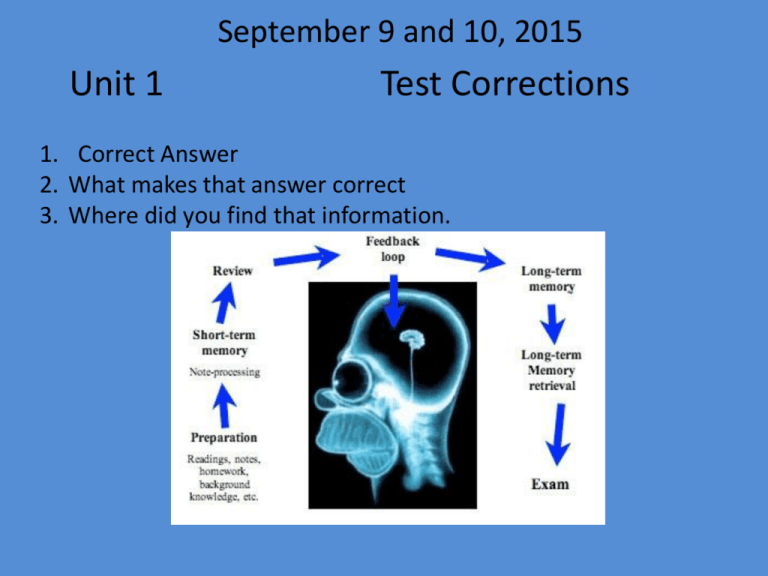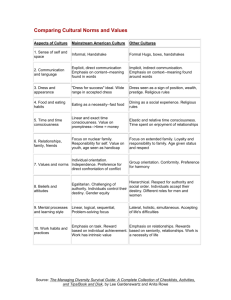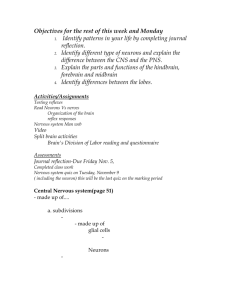Document 9526925
advertisement

September 9 and 10, 2015 Unit 1 Test Corrections 1. Correct Answer 2. What makes that answer correct 3. Where did you find that information. Journal #1 September 11/14, 2015 Unit 1 Test Corrections due 9/16/15; Make sure you are in dress code!!! If your brain were removed, replaced by another, and moved to a new body, which would you consider to be yourself, your old body with the new brain, or your new body with the old brain? September 15th and 16th, 2015 Journal #2 Good Morning/Afternoon. There is successful brain research that is found both with and without animal research. Treatments for Multiple Sclerosis and Parkinsons have been found using animal research. Discoveries about the risk of stroke and that sleep apnea is linked to a higher risk of stroke have been discovered without animal research. What are your thoughts on the ethical use of animals in research? What are the pros and cons of both sides? September 17th and 18th, 2015 Journal #3 In staying with our discussions on the brain, please reflect on the following questions. Be sure to use personal experiences to help guide your answers. Do you feel that our brains are still evolving? Have you adapted to do better/different things than your ancestors? What types of things? Why? What about other animals? September 21st and 22nd, 2015 Journal #4 In staying with our discussions on the brain, please reflect on the following chart. Brain to Body Weight ratio Mammal Body weight Brain weight Blue whale Lion Rat Human 60 000 kg 200 kg 200g 70 kg 6kg 200g 3g 1.3 kg How much of the animal is its brain? 0.01% 0.1% 1.5% 1.9% Using the chart above, what can you gather about the human brain? What can you gather about the brain of other animals? What do you think all this means? Brain to Body Weight Mammal Body weight Brain weight Blue whale Lion Rat Human 60 000 kg 200 kg 200g 70 kg 6kg 200g 3g 1.3 kg How much of the animal is its brain? 0.01% 0.1% 1.5% 1.9% September 23 and 24, 2015 Journal #5 We have been talking about ways our brains control our bodies. What about the ways that we can impact our brains? Be in Dress Code!!!!!!!!!!!!!!!!!!!!! !!!!!!!!!!!!! When does your brain feel like it is functioning the best? When do you feel that you are thinking with the most clarity? What things/strategies do you use to help think with most clarity? What do you do to feel the smartest? September 25 and 28, 2015 Journal #6 Good Morning/Afternoon. Today we will begin discussing our nervous system and its’ divisions. Before we start, I would like for you to reflect on the following question; Make sure you are in dress code!!! Describe a time in your life, the more vivid the memory the better, that you were especially mad/angry. Try not to share it with anyone else. The better the description, the better the experiment. We will be using this later today. September 30, 2015 Journal #7 We have talked at length about the different parts of the brain. For today’s journal, I would like for you to describe a scenario that shows each part of the brain in use. -frontal lobe -temporal lobe -parietal lobe -occipital lobe -cerebellum Be in Dress Code! October 5 and 6, 2015 Journal #7 Today we are going to discuss a few more parts of the human brain. One of the interesting parts of the brain is what is called the Corpus Callosum. Based on this image, what do you feel the purpose of the Corpus Callosum and what could happen if it fails to do its job. Were you correct? October 7 and 8, 2015 Journal #9 Think back to our notes over the Autonomic Nervous System. What is the difference between the Sympathetic and Parasympathetic nervous system? What would be an example of each nervous system at work? October 9 and 12, 2015 Journal #10 Please respond to the following statement/question in 4-5 complete sentences. Make sure you are in dress code!!! “Imagine you live in a time and place where people no longer suffer from diseases like Parkinson’s, diabetes, heart disease, cancer, organ failure, or Alzheimer’s. Imagine that spinal cords can be replaced and that most forms of paralysis have been eliminated. Imagine that nerves, muscles, and even badly burned skin can be regenerated and replaced. Now imagine that the source of this technology comes from something that can’t be seen with the human eye. While it might sound like space-age technology that we see in science fiction books and movies, imagine that it could actually be a reality.” Would you support this sort of technology? Why/why not? What if this technology comes with many ethical and moral dilemmas? October 15, 2015 Journal #11 Please respond to the following statement/question in 4-5 complete sentences. Make sure you are in dress code!!! The definition of neuroplasticity is; “changes in neural pathways and synapses due to changes in behavior, environment, neural processes, thinking, emotions, as well as changes resulting from bodily injury.” What do you feel the advantages to having neuroplasticity are? What would happen if we did not have this? September 22 and 23, 2014 Journal #4 Today we are going to discuss the many parts of the human brain. One of the interesting parts of the brain is what is called the “blood/brain barrier”. What do you feel the purpose of the blood/brain barrier and what could happen if it fails to do its job. What difficulties could it cause? October 5, 2015 Journal #6? What would you do? Why? What would be the pros/cons? The drug is legal, but costs money. Withdrawal symptoms if you quit, but not death. September 19 and 20, 2013 Journal #4 The three classes of neurons and their functions can be best summarized as: - sensory neurons bring information to the central nervous system; - motor neurons connect the central nervous system to muscles and glands; - interneurons are central nervous system neurons that connect sensory neurons with motor neurons. Which do you feel is the most important type of neuron? Support your answer. September 23 and 25, 2013 Journal #5 What do you feel hypnosis is? Do you think it works? If so, or if not, would you participate? Why/why not? October 1, 2012 What do each of the following 3 patterns mean to you? Journal #7 D D D D DDDDDDDDD A stitch in time saves nine October 1, 2012 What do each of the following 3 patterns mean to you? L: A bunch of D’s R:The Letter L L:It’s about sewing R:A small effort now saves time later L:Dots and Blobs R:A face/horse Write down a brief description (couple words) of a scenario that has made your incredibly angry in the past. Journal #7 D D D D DDDDDDDDD A stitch in time saves nine October 4 and 5 Journal #9 One of the many unanswered questions relating to our human brains is the idea of consciousness. How would you describe consciousness? What types of experiences can be considered conscious? How can we test consciousness? If I ask you to remember your first day of school, and the memory comes flooding back, is that in your consciousness or not? October 6 and 7, 2014 Journal #8 We have used the word intelligence throughout the Biopsychology unit, but have not really talked in depth about what we think intelligence truly is. What is your definition of intelligence? What types of situations test our intelligence? What is a lack of intelligence? Can our level of intelligence change? What makes it change? October 8, 2014 We will be going to the media center shortly, don’t get too settled. Make sure you are in dress code. October 4, 2011 Journal #6 If we keep using computers as much as we do, will they eventually take over for our brains? Why/why not? October 10, 2011 Journal #7 What would happen if there were no synapses between neurons? October 15 or 16, 2014 Journal #11 If you were describing how the brain influences behavior to someone who knows nothing, what would you say? Be sure to include everything. Make sure you are in Dress Code!! October 15 or 16, 2013 1. You have 5 minutes to turn your journals in on the front table and look over your study guide. A. Remember to add a post it note if you are keeping them in a binder 2. You will need; -pencil -piece of paper 3. Keep all test materials until the end of class. 4. Turn Vocab in







